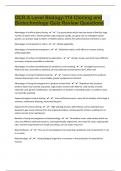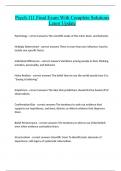OCR A Level Biology:114 Cloning and
Biotechnology Quiz Review Questions
Advantages of artificial plant cloning - ✔ ✔ Can grow plants which have low levels of fertility, large
number of plants with a known genetic code produced rapidly, can grow rare or endangered plant
species, can produce large numbers of seedless plants, disease free plants because meristem is used
Advantages of entrapment in matrix - ✔ ✔ Widely applicable
Advantages of membrane entrapment - ✔ ✔ Relatively simple, small effect on enzyme activity,
widely applicable
Advantages of surface immobilisation by adsorption - ✔ ✔ Simple, cheap, used with many different
processes, enzymes accessible to substrate
Advantages of surface immobilisation by covalent or ionic bonding - ✔ ✔ Strongly bound so less
likely to be lost, accessible to substrate, pH and substrate concentrations don't affect rate
Advantages of using immobilised enzymes - ✔ ✔ Can be reused, can be separated from products,
reduces downstream costs, more reliable, greater temperature tolerance
Advantages of using microorganisms to produce human food - ✔ ✔ Reproduce fast, produce
proteins faster than animals and plants, high protein content with little fat, wide variety of waste
materials used, genetic modification, not dependent on weather or breeding cycles, no welfare issues,
can taste like anything
Arguments against animal cloning - ✔ ✔ Very inefficient process, many fail to develop, miscarriage is
common, malformed offspring, shortened lifespans
Arguments for animal cloning - ✔ ✔ High-yielding animals, GM embryos can be replicated and
develop to give many embryos from the original procedure, cloning specific animals, enabling rare or
extinct animals to be reproduced
Benefits of using microorganisms in biotechnology - ✔ ✔ No welfare issues, wide variety which can
carry out different chemical reactions, can be genetically engineered, very short life cycle, rapid growth
rate, nutrient requirements are simple and cheap, can use waste resources
Bioremediation - ✔ ✔ The use of microorganisms to break down pollutants and contaminants in soil
or in water
Biotechnology - ✔ ✔ Using biological organisms or enzymes in the production of materials for
humans
, Callus - ✔ ✔ Group of undifferentiated genetically identical cells
Conditions for penicillin production - ✔ ✔ Relatively small fermenters, continuously stored to keep it
oxygenated, rich nutrient medium, contains a buffer to maintain pH, temperature maintained at 25
degrees celsius
Conditions to maintain in bioreactors - ✔ ✔ Temperature, nutrients, oxygen, mixing, asepsis
Culture broth - ✔ ✔ Medium, waste products, microorganisms, product
Death stage - ✔ ✔ Reproduction has pretty much stopped, death rate of cells increases
Difference between micropropagation and tissue culture - ✔ ✔ Micropropagation is a type of tissue
culture
Disadvantages of artificial plant cloning - ✔ ✔ Skilled workers required, have to make sure tissue
isn't infected with a virus, infection possible during production, all plants at risk when environment
changes or when exposed to a disease, limits evolution, large numbers of plants lost during production
Disadvantages of entrapment in matrix - ✔ ✔ Expensive, difficult to entrap, substrate has to diffuse
which can slow down rate
Disadvantages of membrane entrapment - ✔ ✔ Relatively expensive, substrate has to diffuse
Disadvantages of surface immobilisation by adsorption - ✔ ✔ Enzyme easily lost
Disadvantages of surface immobilisation by covalent or ionic bonding - ✔ ✔ Active site may be
modified in the process
Disadvantages of using immobilised enzymes - ✔ ✔ Reduced efficiency, higher initial cost, higher
initial cost of bioreactor, more technical issues
Disadvantages of using microorganisms to produce human food - ✔ ✔ Can produce toxins if not
optimum conditions, have to be separated from the nutrient broth, needs sterile conditions which is
expensive, concerns over GM, protein has to be purified, people don't like eating food grown on waste,
needs additives
Electrofusion - ✔ ✔ When the nucleus from a somatic cell is placed next to the enucleated ovum and
fuses with it when the electric current is introduced
Enzyme used in the conversion of dextrin to glucose - ✔ ✔ Glucoamylase
Enzyme used in the conversion of glucose to fructose? - ✔ ✔ Glucose isomerase
Enzyme used in the formation of semisynthetic penicillins? - ✔ ✔ Penicillin amylase






